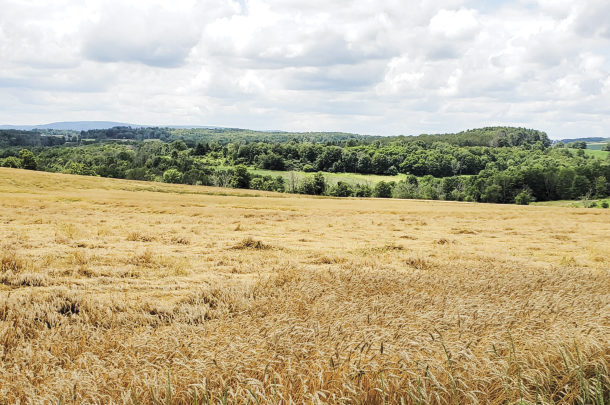Over the summer, the western drought and heat wave continue to intensify. This billion-dollar weather and climatic disaster is one of eight occurring in the U.S. since January, according to the National Oceanic and Atmospheric Administration tracking tool.
East of the Mississippi, July deluges inundated farmland from Louisiana to New England. Cornfields in Iowa, Illinois, Kansas and Ohio were laid over by 90-mph winds in June, and ready-to-harvest wheat fields across northern Pennsylvania suffered significant wind damage from torrential downpours in mid-July. In parts of South Jersey and throughout the midwest, grasshopper populations have exploded.
Leaf feeders like Japanese beetles, thrips and mites vector viral diseases to plants, and their voracious appetites leave plants vulnerable to bacterial infections. Some insects in and of themselves are harmful if ingested with dried forages. Remember, fleas and hay mites are hosts to tapeworms. But beyond yield losses from downed crops and pest damage, the biggest concern at harvest and in storage are mycotoxins.
What are mycotoxins?
Certain types of plant molds release toxins as a natural secondary metabolite as they colonize host tissue. Adverse weather significantly increases mold production in monoculture crops. High humidity and fluctuating night and daytime temperatures promote mold growth. Some molds visibly grow in humans and animals. This form is called mycoses. Athlete’s foot is one example, as are several pulmonary inhaled infections. Other fungi exude toxins that when consumed are detrimental and even lethal. These diseases in humans are called mycotoxicosis.
In animals, symptoms of infection can present as acute (death) or chronic. Symptoms may start out as refusal of feed and progressive reduction of feed consumption, resulting in nutrient level deficiencies. Rumen fermentation, immunity and reproduction issues can occur. Wheezing, nasal and eye discharge are common in animals sensitive to airborne molds. In more severe cases, neurological and other behavioral symptoms can result from mycotoxin ingestion.
In general, large rumimants have more capacity to resolve mycotoxin effects than horses, swine, sheep and chickens. Youngstock of all species are particularly vulnerable to inhalation of mold spores and ingestion of mycotoxins. Handlers of infected feed stock are equally susceptible. If you or your workers must handle moldy feeds, wear a fitted dust mask rated to filter out mold particles and do not expose children to air that is circulating mold spores. Infants and toddlers can ingest mold spores stuck to objects they put in their mouths.
What mycotoxins are of concern in livestock forages?
The mold groups of concern in livestock forages, feed and inhalation exposure are aflatoxin, citrinin, ergot alkaloids, fumonisins, ochratoxin A, patulin, trichothecenes and zearalenone.
Pathogenic zygomycota: Bread molds are typically referred to as the spore-producing fungi. A common example is the black mold rhizopus that grows on bread. Others, like pilobolus, can be found growing on animal dung. Another type in this division called conidiobolus spp. has been found to be the cause of granulomas in the nasal cavities of horses and sheep.
Pathogenic oomycota: Fungus-like eukaryotic microorganisms like pythium species can infect plants and animals. Downy mildew is an example of a pythium species. Potato blight and tomato blight are two examples of phytophthora. These water molds cause considerable foliar and fruit losses in many vegetable crops. Pythium insidiosum is a well-known waterborne fungal infection of livestock, particularly sheep, and is responsible for deaths of the famous Chincoteague ponies. Necrotizing rhinitis, bloody nose and visible deformity of the nasal cavity occurs.
Pathogenic ascomycota: Yeasts and sac fungi include ergot fungi, powdery mildews, apple scab and the black knots of plum and walnut trees. Cattle are by far the most susceptible to ergots. But any foraging animal, including pastured chickens, can be sickened from ergot poisoning produced by clavicep fungi. Vasoconstriction of blood vessels results in damages to the tips of ears and tails, and in more severe cases, neurological issues. Cattle will generally refuse to eat feed with visible signs of the black-colored ergot bodies. In addition to fescues, ergot fungi can infect pasture grasses like brome, feather, foxtail, orchard, quack, red top, rye and timothy.
Fusarium molds are also in this division. Horses are particularly susceptible to fusarium molds. Learn to recognize the signs of fusarium by looking at infected corn ears and in lawns exhibiting the circular pattern common to fusarium in vegetative grasses. In small grains, look for bleached, off-colored grain husks and tiny circular dots that progress from pink to black in the spikelet.
Are mycotoxins a concern in the 2021 crop harvest?
Mycotoxins are a diverse family of agents and development hinges on a complex relationship of varietal, nutrition, residual inoculum in crop residue and weather. One key ingredient to look for is stress on the crop during grain development and maturity. Let’s take a look at the condition of the national crop progress reports from the USDA to get a snapshot of commonly fed livestock feedstocks as they have progressed this growing season.
Small grains: The bulk of the oat and barley crop headed by mid-July, ahead of previous years. The majority of these two crops lags behind the previous five years for good to excellent quality, but overall is still looking to be in the fair to good range coming into harvest. Wheat condition is not as good as 2019 but well above 2018’s crop rating. High heat and humidity favor mycotoxin development in small grains, especially during flowering, which would have occurred in mid-June across most of the national crop. Fusariums are the leading cause of concern in small grains, followed by deoxynivalenol (DON) and zearalenone mycotoxins.
Corn: Approximately 30% of the nation’s corn crop was beginning to silk by mid-July. Most reports indicate field corn is in good to excellent condition, on par with the 2017 crop quality and well above 2019’s crop. But it is too early yet to evaluate corn for mycotoxin development at this stage. Check the mid-August crop progress report to see if crop quality ratings change. Drought stress can lead to proliferation of aflatoxins and fumonisins growth. Conversely, fusarium fungi that produce vomitoxins coincide with excessive precipitation and lack of sunlight.
Peanuts: Peanuts are off to a good start. 70% of the crop was in good to excellent condition in mid-July. Insect damage to the developing seed/pod, drought and high soil temperatures are key influencers on mycotoxin development. Mid-July is when peanuts begin to develop seeds. Look for the October crop progress report for an indication on how the growing season finished out. Aflatoxins are the most commonly found mycotoxin in peanuts and hulls, followed by penicillums and rhizopus.
Cotton: Cotton progress as of mid-July was on par with peanuts. There is a stark distinction in mycotoxin development between the southwestern region and southeastern region of cotton production, due to differences in the climatology of these regions. Aspergillus is the most commonly found mycotoxin in cotton feedstuffs.
Soybeans: Soybeans in general are the least-likely crop to develop mycotoxin problems. The national crop is off to a good start. However, insect pressure is quite high this year across the entire soybean crop. In the east, high humidity and frequent precipitation coupled with high heat are of concern as plants begin to flower. If there are any signs of mold in soybean pods, test soybean feedstuff for fusariums, which include the vomitoxin referred to as DON.
What about dry hay?
Insect presence and moisture levels above 18% can turn what looked like “dry enough to bale” into musty, dusty hay in storage. This type of “dust” is different from the dust of overmature, very dry chaff and often has an associated “off” smell ranging from “sweet” to “bitter.” Mycelium threads of mold growth and microbial volatile organic compounds that molds produce are not always seen or smelled by humans. But cattle sense of smell is two, three, even five times more acute. Animal behavior is by far the most accurate indication hay is unfit to feed. Molds of most concern are alternaria, aspergillus, cladosporium, fusarium, mucor, penicillium and rhizopus.
Do mycotoxin levels increase in storage?
The simplest answer is yes. Proper moisture and control of humidity is key to keeping stored feed in “stable” condition and to slow natural deterioration. Peanuts and soybeans can easily increase in mycotoxin levels due to poor storage conditions. Corn kernels and cobs stored above 20% moisture are at significant risk of developing mycotoxins after harvest.
What are the guidelines for mycotoxin levels in feeds?
Most youngstock and small-bodied animals will be sickened if they ingest mycotoxin levels in corn and peanuts above 20 parts per million (ppm). It is important to monitor feed refusal and react quickly if mold is suspected. Remember to wear a mask if moldy feed must be handled. Cattle can take up to 300 ppm in cottonseed, but milking dairy cattle should not be consuming feeds with greater than 20 ppm in corn and peanuts. In regard to DON levels, the guidelines are no more than 10 ppm, regardless of feed composition or livestock group.
Feeds and hay stocks containing 20 ppm or more of mycotoxins must be handled by humans with care to avoid inhalation.
References omitted but are available upon request by sending an email to the editor.
This is the final article in a series about foraging through the weeds of climate change.













